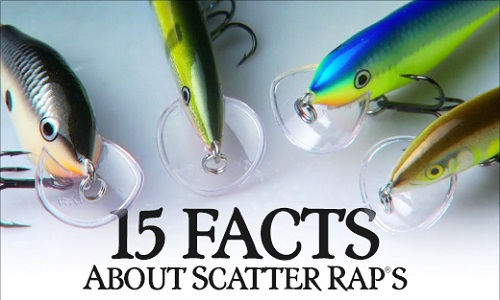 Featuring what’s best described as “evasive action,” Scatter Rap®s perfectly mimic spooked baitfish fleeing attack, moving unpredictably from one side to the next, back to center, and then kicking out to one side again. That built-in ability to change directions is what makes Scatter Raps so deadly, says legendary angler Al Lindner, founder of In Fisherman and host of Angling Edge on TV.
Featuring what’s best described as “evasive action,” Scatter Rap®s perfectly mimic spooked baitfish fleeing attack, moving unpredictably from one side to the next, back to center, and then kicking out to one side again. That built-in ability to change directions is what makes Scatter Raps so deadly, says legendary angler Al Lindner, founder of In Fisherman and host of Angling Edge on TV.

“That’s the first new concept I’ve seen in crankbaits to come along in a long, long time,” he says.
If Al Linder hasn’t seen it before, you can bet fish haven’t either!
2. Gettin’ Lippy — The Scatter Rap’s Secret Is In Its Lip
What make a Scatter Rap unique is its “revolutionary,” curved Scatter Lip, Lindner explains. That lip shape — which resembles half a Pringle potato chip — creates a “built-in triggering mechanism” that’s “incredible,” he says.
3. No Experience Needed — The Scatter Rap’s Action Is Built In
To catch fish with a Scatter Rap, no elaborate rod-tip maneuvers, wrist motions or jigging strokes are necessary. “You don’t have to do anything but reel,” Lindner explains. The Scatter Lip creates all the action for the angler.
4. New Moves — The Scatter Rap Lineup Complements Classic Wounded-Minnow Action With Fleeing-Minnow Moves
In 1936, Lauri Rapala made history with the wounded-minnow action of the Original Floating® Rapala®. In 2013, Rapala made history again with the Scatter Rap’s unique evasive action.
“It brings the natural scenario of a baitfish fleeing a predator to life by emitting a scattering action any time, anywhere,” says 2003 Bassmaster Classic Champion Michael Iaconelli. “The only difference? Unlike in nature, this one doesn’t get away!”
5. Have We Met Before? — Scatter Raps Might Look Familiar
If you don’t look closely, you might confuse Scatter Raps with baits already in your tackle box. That’s because they’re built on classic Rapala body shapes bolstered by Scatter Lips.
The Scatter Rap minnow resembles an Original Floating Rapala. The Scatter Rap CountDown is almost identical to the non-scattering bait of the same name. The Scatter Rap Shad mimics the Shad Rap’s tried-and-true shad shape. And the Scatter Rap Crank looks similar to a DT series crankbait.
6. Water Column Covered — The Scatter Rap Line-Up Includes Shallow, Mid-Depth And Deep Runners
While the initial Scatter Raps ran five to nine feet, the Scatter Rap Crank Shallow covers water three feet deep and shallower and the Scatter Rap Crank Deep dives to ten feet.
But depth numbers alone don’t tell the whole story – Scatter Raps not only cover the water column vertically, they extend coverage horizontally as well. “You’re getting a directional change not only up and down, but also left or right,” Al Lindner explains. “That’s what triggers fish.”
7. Come One, Come All — The Scatter Rap Is A Multi-Species Bait
With unmatched versatility, Scatter Raps have yielded everything from Midwest walleyes, to Texas largemouth and white bass, to Florida speckled sea trout, to California lake trout and largemouth, and smallmouth across the country. Cast or trolled, Scatter Raps are ideal for multiple applications.
8. Fish Out Of Joint? Scatter Raps Come In A Jointed Version For Finicky Fish
The Scatter Rap Jointed’s broken-back style allows for even more action than a regular Scatter Rap — and at slower retrieve speeds — making it a perfect bait for after cold fronts, when fish are traditionally finicky and in a negative feeding mood.
Built on a classic, articulated Rapala Jointed Minnow balsa body, the Scatter Rap Jointed swims like an injured minnow beating a fleet retreat. That action, unlike anything fish have seen in a bait before, is what triggers strikes from otherwise uninterested or hesitant fish.
9. Commence The Smack Talk — Scatter Raps Can Make Novices Think They’re Master Anglers
Scatter Raps have so much action built in they could cause a novice angler to out-fish a seasoned pro.
“This thing’s going to make your brother-in-law that doesn’t fish think he’s a Master Angler,” quipped one Rapala insider after boating fish after fish with a Scatter Rap one summer afternoon on Lake of the Woods. “And of course, if he out-fishes you with it, you’ll never hear the end of it!”
10. Epic Challenge — In The 2013 Scatter Rap Challenge, Six Anglers Fishing Only Scatter Raps Caught 1,019 Fish Over 5 Days
The Scatter Rap Challenge, contested in five days over 100 miles of Minnesota’s famed Lake of the Woods, was “all about trying to figure out how versatile the Scatter Rap is — the situations it can be used in; where it excels,” says In-Depth Outdoors TV Host James Holst, captain of the Scatter Rap Challenge’s Red Team. “And what we found is that with just small adjustments to presentation, this is an incredibly versatile bait line-up.”
Fishing in three two-man teams, Scatter Rap Challenge competitors caught hundreds of smallmouth bass, Northern Pike, sauger and walleye. They were allowed to fish only four baits — a Scatter Rap Minnow, Scatter Rap Shad, Scatter Rap CountDown and Scatter Rap Crank.
11. Cause The Pause — Scatter Raps Trigger Bites Even When You Stop Reeling Them
Because Scatter Rap bodies are constructed of balsa wood, they float, explains Mark Fisher, Rapala’s Director of Field Promotions and captain of the Scatter Rap Challenge’s Yellow Team. “So when you stop the retrieve, the bait starts floating up,” he says.
In addition to the Scatter Rap’s erratic side-to-side action when reeled, that slowly rising action on the pause can elicit bites too. “So it’s always got a triggering action to it,” Fisher says.
12. Get The Lead Out — Trolled On Lead Core Line, Scatter Raps Are Terrific At Tempting Up Deep-Dwelling ‘Eyes
While trolling Scatter Rap Minnows during the Scatter Rap Challenge, Red Team Captain James Holst enjoyed “one of the higher-number days of walleyes caught in my boat ever.” Trolled on Sufix 832 Advanced Lead Core line in Lake of the Woods’ main basin, Holst found that the Scatter Rap’s inimitable action is “just deadly,” putting dozens of fish in the boat in just a short time.
“What makes the Scatter Rap perfect for this type of trolling is that most crankbaits just go in a straight line,” Holst explains. “This Scatter Rap gets down there and it starts searching around. It’s a great triggering effect.”
13. Big Bait, Big Fish — Bigger Scatter Raps Often Yield Bigger Fish
Scatter Rap Challenge competitors found that Scatter Rap Minnows — the largest offering in the Scatter line-up — produced the biggest walleyes (and fewer dink saugers).
“The larger fish were keying in on the bigger-profile baits,” recalls Scatter Rap Challenge Black Team Captain Joel Nelson, who caught one of the biggest walleyes of trip — a 29 3/4-inch, 9 1/2-pounder.
Nelson and his co-angler caught a combined 64 walleyes and sauger on the day he caught the 9 1/2 pounder. That beast came on a Scatter Rap Minnow in the Golden Alburnus color pattern. “When the big ones are monsters, I’ll trade quality over quantity!” Nelson says.
14. Bite-Size Balsa — Scatter Rap Shads Come In A Finesse Size
Bigger isn’t always better. To give anglers a finesse option when fish get finicky, Rapala released a 2-inch Scatter Rap Shad in 2014.
“From lake to lake, region to region, baitfish populations come in different sizes,” explains Tom Neustrom, a Freshwater Hall of Fame Legendary Guide. “When gamefish are keying on smaller forage — or just being finicky — a smaller offering is often what it takes to get them to bite.”
The two-inch Scatter Rap Shad measures 3/4 of an inch shorter than the original and weighs 1/16 oz. less.
15. Not A Grinder — Unlike Most Crankbaits, Scatter Raps Are Not Designed For Prolonged Bottom Contact
While most lipped crankbaits are created for prolonged bottom contact, Scatter Raps were not designed for “down and dirty grinding,” says Mark Fisher. “If you’re making constant bottom contact, you defeat the purpose of the bait’s erratic, lateral movement,” he explains.
That being said, occasional caroms off the bottom can complement the Scatter Rap’s built-in action. “While it’s not a thick-lipped grinder in the classic sense, it will deflect off sand, gravel and rocks,” Fisher says.
